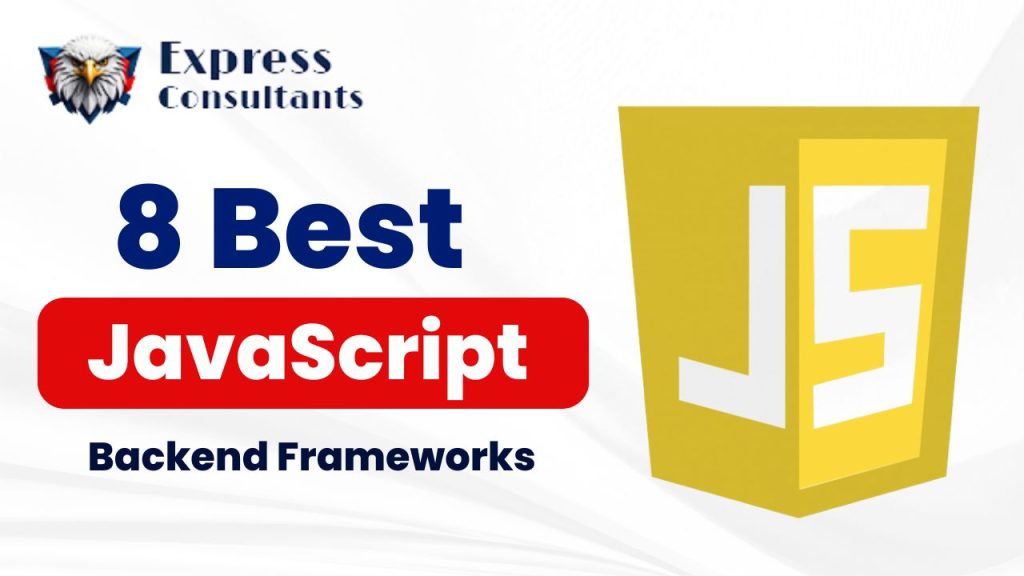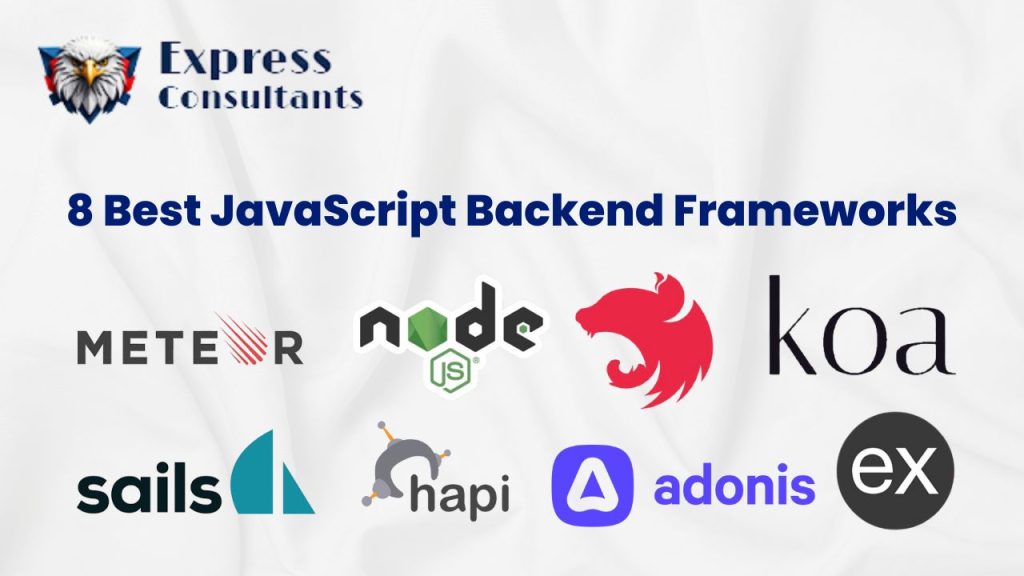
8 Best JavaScript Backend Frameworks
September 20, 20248 Best JavaScript Backend Frameworks
With over 98% of websites using JavaScript, it’s hard to imagine a world without it. Most of the time, we associate JavaScript with frontend development, crafting the interactive parts of a webpage. But, JavaScript is just as mighty on the backend. This article explores the best JavaScript backend frameworks available today, focusing on speed, scalability, and community support.
What Are JavaScript Backend Frameworks?
In simple terms, JavaScript backend frameworks help developers build the server side of an application. Imagine a framework as the skeleton of your app, providing the necessary tools and structure to create a backend that works seamlessly with the frontend. With JavaScript growing popular for full-stack development, frameworks have evolved to assist with everything from handling HTTP requests to managing databases.
Backend frameworks built on JavaScript aren’t just about functionality—they’re about efficiency. They allow developers to write cleaner, more maintainable code. But let’s face it, with so many options, how do you even choose the best JavaScript backend framework?
A Quick Overview of Backend Frameworks
Before diving into specifics, let’s talk about why you’d want to use a backend framework in the first place. Backend frameworks offer:
- Pre-built components: You don’t have to start from scratch.
- Efficient routing: These frameworks know how to send users where they need to go.
- Database integration: They handle connecting to and communicating with databases.
- Middleware support: To make things even more flexible, these frameworks offer middleware to process requests.
Now, let’s talk about some of the best frontend frameworks that also offer amazing backend support!
Top 8 Best JavaScript Backend Frameworks in 2024

1. Node.js (Runtime)
It’s impossible to start this discussion without mentioning Node.js, arguably the most well-known JavaScript runtime. Powered by Google’s V8 engine, Node.js allows developers to write JavaScript for both client and server-side applications, making it a preferred choice for full-stack development.
Why Node.js?
- Speed and Performance: Node.js excels at handling real-time applications like chats, collaboration tools, and streaming platforms. Its non-blocking, asynchronous architecture means it handles multiple requests simultaneously, making it incredibly fast.
- Vibrant Ecosystem: With NPM (Node Package Manager), developers have access to thousands of packages and tools, allowing for rapid development and customization.
- Community Support: Given its popularity, you’ll always find an answer to your problem somewhere on the internet. It’s widely adopted, and tons of tutorials, forums, and resources are available for beginners and advanced users alike.
- Side note: If you’re diving into full-stack development, learning Node.js is almost a rite of passage. Most modern JavaScript backend frameworks like Express.js and NestJS are built on top of Node.js, making it an essential tool to master.
2. Express.js
If you’re using Node.js, you’ll likely come across Express.js, one of the most lightweight and flexible frameworks for building web applications. It’s minimal but highly extensible, letting you build scalable apps without tons of bloat.
Advantages:
- Simplicity: Express lets you handle routes with ease, and setting up middleware is straightforward.
- Flexibility: You can add exactly the modules you need without being bogged down by unnecessary features.
- Speed: It’s built on top of Node.js, meaning you get the same non-blocking, event-driven architecture.
Express.js is perfect if you’re looking for something quick and easy but still powerful enough to handle complex apps.
3. NestJS
Now, if you want something more structured with TypeScript support, NestJS is the best JavaScript backend framework for you. Inspired by Angular, Nest provides a modular architecture that allows developers to create highly testable, scalable, and maintainable server-side applications.
Why NestJS?
- Modularity: Nest forces a modular structure, making large applications easier to maintain.
- TypeScript First: Nest is built with TypeScript in mind, giving you all the benefits of static typing.
- Compatibility: You can easily integrate it with other libraries or frameworks, even those from outside the Node.js ecosystem.
It’s perfect for building enterprise-level applications with well-defined architecture.
4. Koa.js
Built by the same team that developed Express, Koa.js is a more modern take on web frameworks. Unlike Express, Koa focuses on being even lighter and more modular. Instead of giving you everything out of the box, Koa is designed to give you flexibility—no middlewares are bundled, so you can use only what you need.
Why Koa.js?
- Minimalistic: No unnecessary bloat. Use only the components you need.
- Modern Design: Koa was built with async functions from the start, meaning it’s future-proof for handling asynchronous code.
- Clean Syntax: Koa’s use of generators and async/await makes writing non-blocking code more intuitive.
If you love Express but want something sleeker and more modern, Koa is definitely worth checking out.
5. Sails.js
For developers looking to build robust APIs or real-time applications, Sails.js is a fantastic choice. It’s a full-featured MVC (Model-View-Controller) framework built on top of Node.js. Sails simplifies many tasks and comes with built-in support for WebSockets, making it ideal for apps requiring real-time updates, such as chat apps or dashboards.
Why Sails.js?
- Data Agnostic: Sails works with any database, whether you’re using SQL or NoSQL.
- Real-Time Features: It makes building apps with WebSockets a breeze.
- Convention Over Configuration: Sails follows the philosophy of giving developers sensible defaults, so you don’t have to spend time configuring every little detail.
Sails.js is great if you want an opinionated framework that does a lot for you out of the box.
6. Hapi.js
Originally created by Walmart, Hapi.js is a secure, reliable framework ideal for building scalable applications. It provides a strong plugin system and focuses on configuration over code, which is perfect for large teams or enterprises looking for consistency in their codebase.
Advantages of Hapi.js:
- Robust Security: Hapi includes built-in security features, making it ideal for apps that require strict security protocols.
- Extensibility: Hapi’s plugin architecture allows you to extend the framework easily.
- Configuration Over Code: Hapi favors configuration, meaning you can adjust behavior without having to write extra code.
Hapi.js works well for large-scale apps with a need for security and customization.
7. Meteor.js
If you’re after a full-stack solution, Meteor.js is one of the best JavaScript frameworks that handle both frontend and backend development seamlessly. Meteor makes building real-time web apps simple and fast, handling everything from the database to the frontend with ease.
Why Meteor.js?
- Full-Stack Integration: Meteor allows you to use the same JavaScript code for both the frontend and backend.
- Real-Time by Default: Meteor’s real-time data synchronization makes it perfect for collaborative applications.
- Ecosystem: With its own package system, Meteor lets you easily integrate third-party tools.
Meteor is excellent for startups or developers wanting an all-in-one solution that covers both client and server-side.
8. AdonisJS
AdonisJS is a Laravel-inspired Node.js framework that offers a solid foundation for building web applications with a well-structured architecture. It’s ideal for developers who want to build fast, scalable, and maintainable apps with minimal setup.
Why AdonisJS?
- Built-In ORM: Adonis comes with a powerful Object Relational Mapper, allowing seamless interaction with databases.
- Complete Solution: Adonis has many features out-of-the-box, so you can focus on building your app without piecing together multiple tools.
- Simple to Use: It’s developer-friendly, with clear documentation and an easy learning curve.
AdonisJS works perfectly for developers who want structure and productivity from the start.
The Advantages of JavaScript Backend Frameworks
Alright, let’s break down why using one of these JavaScript backend frameworks is a game-changer:
- Scalability: Most JavaScript backend frameworks, especially Node.js, excel in scaling. It handles a large number of concurrent connections efficiently, which is critical for growing applications.
- Faster Development: With JavaScript on both the frontend and backend, you can have faster iterations and simpler codebases.
- Cross-platform: Many of these frameworks are cross-platform, allowing apps to run seamlessly on various operating systems.
- Community and Support: With frameworks like Express.js and NestJS, you’ve got a large, active community ready to offer help, making problem-solving a breeze.
Side thought: Have you ever noticed that JavaScript frameworks have such extensive libraries? This makes them versatile—whether you’re working on a simple web app or a high-demand e-commerce site.
Which JavaScript Backend Framework Should You Choose?
When deciding which framework is the best, it depends on the project you’re working on. Here’s a quick breakdown to help you decide:
- For Small Projects: Go for Express.js. Its minimalistic approach means you can focus on getting your app off the ground quickly with less complexity.
- For Complex, Enterprise-Level Projects: NestJS is ideal. It provides a solid structure, ensuring that even as your app grows, the codebase remains clean and manageable.
- For Real-Time Applications: If you’re developing real-time apps like chat applications, online gaming, or live collaboration tools, the Node.js runtime is your best friend. Its event-driven architecture makes it ideal for handling multiple connections efficiently.
- For Lightweight, Minimalist Apps: Koa.js is perfect. With a smaller footprint than Express, it’s great for building clean, modern web apps with fewer dependencies.
- For Scalable, Real-Time Systems: Sails.js is the way to go. It’s great for building real-time apps like chats or multiplayer games due to its built-in WebSocket support.
- For Secure, Large-Scale Applications: Hapi.js is known for its strong focus on security and extensibility. It’s a top pick if you’re working on apps requiring robust security measures.
- For Full-Stack, Real-Time Apps: Meteor.js offers seamless full-stack integration, making it a good choice if you’re looking to build real-time apps with both frontend and backend capabilities in a single framework.
- For Database-Heavy Apps: AdonisJS stands out for apps with significant database interactions, thanks to its built-in ORM (Object-Relational Mapping), making database management a breeze.
| Framework | Scalability | Learning Curve | Ideal Use Cases | Main Strength |
| Node.js | High | Easy | Real-time apps (chats, collaboration) | Speed and performance |
| Express.js | High | Easy | APIs, small to medium-sized applications | Lightweight and flexible |
| NestJS | High | Moderate | Enterprise apps, large-scale projects | Modular and TypeScript-first |
| Koa.js | Moderate | Easy | Modern, minimalistic apps | Clean syntax and minimalism |
| Sails.js | High | Moderate | Real-time apps, APIs, scalable systems | WebSocket and API support |
| Hapi.js | High | Moderate | Large-scale, secure apps | Security and extensibility |
| Meteor.js | High | Moderate | Full-stack apps, real-time apps | Full-stack integration |
| AdonisJS | Moderate | Easy to Moderate | Web apps with database interactions | Built-in ORM and simplicity |
Choosing the best frontend framework to pair with your backend framework is just as important, ensuring you deliver smooth, responsive, and engaging experiences for users.
Conclusion
The world of backend development has been revolutionized by the rise of JavaScript, and the frameworks discussed here—Node.js, Express.js, NestJS, Koa.js, Sails.js, Hapi.js, Meteor.js, and AdonisJS—prove that it’s possible to build scalable, fast, and reliable applications. Choosing the right one depends on your project’s specific requirements and the skillset of your development team. Whether you’re building a simple API or a complex, real-time web application, these frameworks have your back.
In the end, whether you’re just starting out or a seasoned developer, there’s never been a better time to dive into JavaScript backend frameworks.
You may also like : –
- Top 10 Best Frontend Frameworks in 2024: The Future Is Here
- 10 Best Backend Frameworks in 2024
- Top 7 AI Trends To Look Out for in 2024
FAQs
1. What’s the best JavaScript backend framework for beginners?
If you’re just starting out, Express.js is the perfect option. It’s lightweight, easy to learn, and has a massive community that can help you if you get stuck. You can quickly set up an API or a small web app without too much hassle.
2. Is Node.js a framework or a runtime?
Node.js is actually a JavaScript runtime, not a framework. It allows you to run JavaScript on the server, which is why it’s often confused with a framework. However, frameworks like Express.js or NestJS are built on top of Node.js to make backend development easier.
3. Which framework is best for building real-time applications?
For real-time apps like chat platforms or live collaboration tools, Node.js paired with Sails.js or Meteor.js is a great combination. Both offer excellent support for real-time data and WebSockets, making it super smooth to create interactive apps.
4. How do I choose between Express.js and Koa.js?
Both are great, but it depends on what you need. Express.js is more feature-rich out-of-the-box and has been around longer, meaning there’s plenty of support available. Koa.js, on the other hand, is more minimalist, so if you want more control and don’t need all the features of Express, Koa is a solid choice
5. Which framework is best for enterprise-level projects?
If you’re working on a large, complex project, NestJS is your best bet. It’s built with scalability in mind, offers TypeScript support, and is highly modular, making it perfect for big applications that need long-term maintainability.
6. What’s the main advantage of using Hapi.js?
Hapi.js shines when it comes to building secure, large-scale apps. It has a strong emphasis on security features and offers extensive configuration options, so you can fine-tune your app exactly how you want it.
7. Are there any frameworks that provide a full-stack solution?
Meteor.js is a full-stack framework that allows you to build both frontend and backend using JavaScript. It’s especially good if you want a seamless development experience without jumping between multiple technologies.
8. How does AdonisJS differ from other frameworks?
AdonisJS comes with a built-in ORM (Lucid) that makes database handling much easier, especially for projects with a heavy database requirement. It’s also quite easy to set up, with a structure similar to popular frameworks like Laravel (for PHP developers out there).
Ready to unlock your business's potential with custom software
Contact Us

